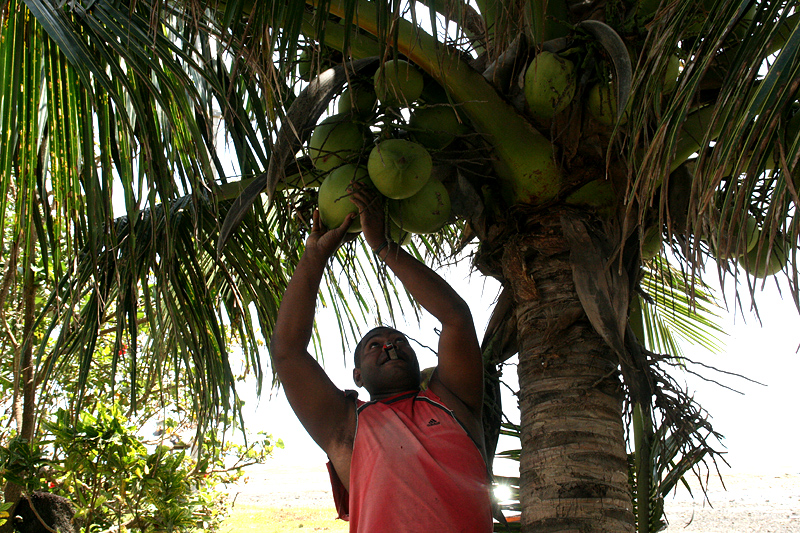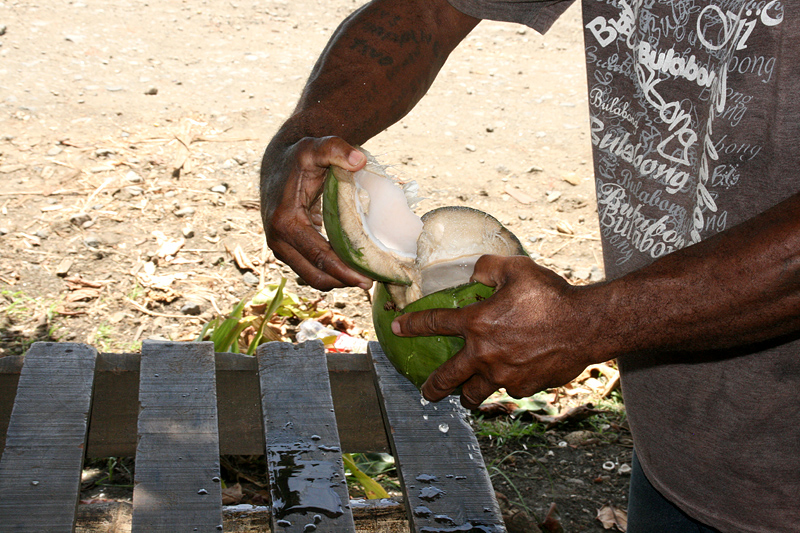Tropical fruits in Fiji
== Mango, Papaya, Pineapple, Banana, Coconut growing wild. You can eat as much as you want ==

[The last renewal of this page: October 20, 2013]
Before I came to Fiji, I thought there would all kinds of tropical fruits in Fiji, however, actually, the number of the kind is less than those contries in Southeast Asia.
However, in the seasons, mango and papaya are anywhere around in this country. We can also find another tropical fruits such as star fruit, although the number and the season is limited. Of course, pineapples and banana are anywhere around all through the year.
What I was surprised is that all these fruits are available growing wild in the garden of many houses and streets, not only in a farm.
 Mango
Mango

This is a mango tree. We can find one anywhere in the island.

In mid-October, mango fruits of a big mango tree near the Nadi Internaional Airport are getting color and are ready to eat soon like other many mango trees in the island.

Coming approach to the tree, it smells very nice sweet-and-sour flavor strongly. As I was looking up the mangos under the tree, the owner of the land came to me.
I asked him for selling some of the mangoes to me.

He asked me when I want to eat them. (He said depending on the time to eat, he would choose the good one.)
He asked me to wait under the tree to receive the mangoes that he would throw.

He climbed up the tree very easily to very high up like a monkey!

He choosed good mangoes and started throw them down. (You see the geen mango being thrown above his hand in the picture)
I caught them, but they are hard and heavy! It was so hard to get them without any gloves・・・・

He has thrown five pieces as I requeste. After all he added two more for free, but all the seven mangoes costed me only F$3.00 (US$1.50)!!
I was surprised to find their strong aroma. I heard the aroma right after being picked from the three is so strong and nice, but it is true!
Witout getting them close to my nose, with just being close to them, I could smell its nice arma very strongly!

It is very popular to find the village people are selling their products along with the road in the village.
They are selling mangoes picked from the trees growing in their property.
Most of the mangoes sold here were still in green.

One plate of mangoes at the right cost F$2.00(US$1.00). As they are still in green, if we try to eat them now, they are hard and so sour like a lemon, but after leaving them for about a week, thery will be ripe with a read clor and taste sweet-and-sour flavor.

In this village, red mangoes are sold. But they say it us F$1.00 (US$0.50) for each! It is too expensive!

This is how it is sold in the Namaka Market. One plate of mangoes cost F$2.00 (US$1.00)

Let's eat now...

Mango has a big seed in itse center, so we need to cut outer part with a knife to eat.
A sweet-and-sour flavor spreds out in the mouth.
 Papaya
Papaya

This is a farm of papaya in the srburbs of Sigatoka.
Big papayas are grown on a short tree which is much shorter than expected.

Wonderful! I wanted to stretch my hand to get them, but they are still too green....

In the garden of my friend's homem there is a small papaya tree. They said they can eat them all through the year.
Just beyound the fence, there is a mango tree and it has a lot of mangoes already. They said when they are ripe, their kids climb it to get the mangoes.(Twice in a year)

Papaya being sold in the Namaka Market without any sepcial care

This big papaya cost F$1.00 (US$0.50) for each.
 Pineapple
Pineapple

We can also find pineapples everywhere, such as in the gardens of the houses and at the road side.

A fine-looking pinapple is grown.

Pineapples are sold in the Namaka Market being displayed without any special care. It is F$1.00 (US$0.50) for each.

Along with a road, it is very popular that the pineapple is sold like this.
They sell of pared pineapple being cut in a half and coold by ice.

Drivers stop the car right if front, and stretch out their hand from the window to by them. They keep on driving eating it just like an ice candy.

Cutting in a half the pineapple that I bought at the market, there contains a lot of juice! A sweet smell spreads in the mouth!
The best way to eat it is to cut vertically in a few pieces, and bite it like we do for watermelon.
 Banana
Banana

Banana treees are anywhere in the garden of houses.


The are still green, but they are already sweet.

Banana being sold in the Namaka Market.
The wild bananas in Fiji have urgly look and looks damaged, but inside is OK and very sweet and delicious.
 Coconut
Coconut

A Coconut is a fruit which grows on a coconut palm, and we can find the them anywhere in Fiji such as gardens, streets, beaches, and fields and mountains.
Coconuts are very big and heavy, and when they get ripe or wind blows strongly, they fall plump. If they fall on our head, it sure will be a big accident.
In the resort hotels, a signboard put on the coconut palm tree which says "Caution! Falling coconuts!" are seen very often.
However, that is something like a signboard in the moutain along with the road saying "Caution! Falling rocks", and I get troubled how I can watch out.
The coconuts in the picture are yellow which are less popular. Most of coconut palm trees bear green coconuts.

This is a picture that is taken in the exhibition for agricultural products in Lautoka. There are many kinds of coconuts like in the picture.
The white part is scraped off as the materials for coconut milk and coconut oil, and also it is used for cooking.
The vacant part is filled up with a coconut juice (almost no color and transparent).

When I visited Ovalau island, in one village, a young boy got a coconut for me.

He cut it with a big hatchet (they call it a knife, simply) to open the coconut. (It is so hard that kitchen knives will never work)
He let me dring a coconut juice inside. It was a delicious natural juice. Quite a lot of juice was in there.

Coconuts being sold in the Namaka Market. Green coconuts which are for drinking coconut juice are also sold, but most of them are hairy coconuts like this.
Looking at the web pages and blogs in Japan, there are various opiniguesswork regarding the difference of these two different coconuts, but they are the same things originally.
When the green coconuts get ripe, the color changes to yellow, then to brown, and finally, they get hairy. As it is after being dried, they naturally get smaller.
The white sarcocarp of coconut and the juice are there as they were, the taste of the juice get stronger as much as they got ripe.

This is a picture to show the inside of a hairy coconut being scraped the white sarcocarp, after cutting a hairy coconut in a half to drink juice.
The rind got thinner and harder as much as it got dry. Using this shell, they make a cup by dressing and polishing the rind for drinking Kava (Although it's not an alcohol, it is a drink made by grinding roots of Kava tree to strain with a water.)

This is the sarcocarp of coconut being scraped. This is delicouos! It has a flavor of coconut and a little bit sweetness, and is is so nice to eat.
Adding sugar to this, it will be a perfect confectionery.
A coconut milk is made by squeezing this, and a coconut oil is made by abstracting ingredient of oil from this.
The basics of fijian food is this coconut milk. They cook and dress fish or vegetable with a coconut milk.


 In case you hit this
page directly from a Search Engine, you can reach to all of the pages of MAFNET from Top Page
In case you hit this
page directly from a Search Engine, you can reach to all of the pages of MAFNET from Top Page

































